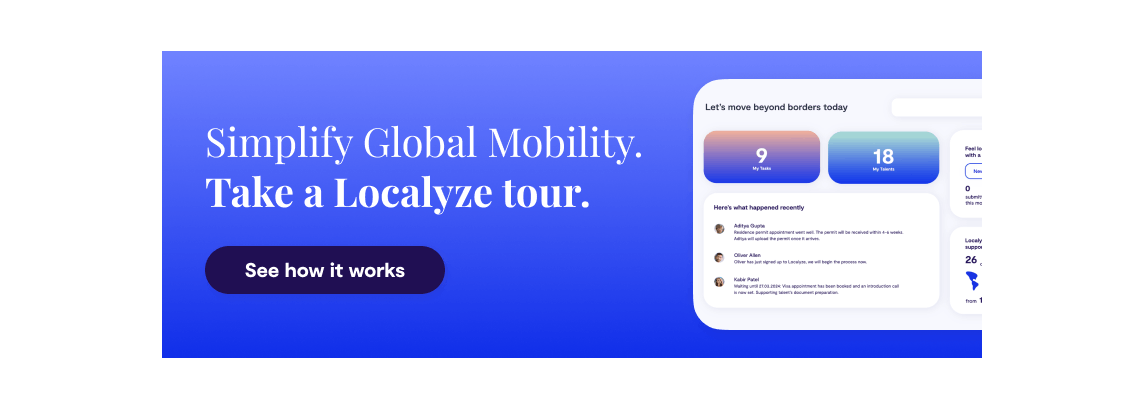Over the last few years, there’s been a lot of discussion surrounding the “future of work.” Among other initiatives, many companies have started adopting distributed work models to align themselves with the “new normal.” This shift towards location flexibility, allowing employees to work from virtually anywhere, means the global workforce is starting to expand and move across international borders.
To prepare for and sustain this transition, companies with on-the-go employees need something very important: a Global Mobility strategy. It’s the foundation upon which mobile workforces are built.
In this article, we’ll cover the basics of Global Mobility: what it is, why it’s beneficial, and what to keep in mind when building out a Global Mobility strategy.
What is Global Mobility?
Global Mobility, or employee relocation, is an HR function that enables companies to transfer employees across borders from one location to another. These transfers, also known as assignments, can broadly be classified as one of the following: business travel, short-term, long-term, or permanent. Read more about each below.
Business travel
Business travel typically involves short trips to a different country. The purpose of these trips can include, but is not limited to:
- Attending conferences and meetings
- Negotiating contracts
- Networking
Further reading you might like: Ultimate business travel compliance checklist
Workation
The word "Workation" is a combination of “work” and “vacation”. A workation is essentially an employee initiated trip, primarily taken for personal reasons, where they continue to work from a new location rather than taking PTO while away.
The main difference with business trips is that the latter are travels that are initiated by the company for work purposes such as an offsite, team meet-ups, visits to a vendor, conference attendance, or visiting other offices.
Further reading you might like: Comprehensive workations compliance checklist
Short-term assignments
Short-term assignments are typically three to twelve months in duration. These international assignments are usually designed to fulfil a short term goal. For example to:
- Train local staff in a particular skill or proficiency
- Fill a vacancy until a more permanent solution is introduced
- Participate in an initiative or project
Short-term assignments can help develop talent within your organisation by offering employees valuable international exposure and experience. Employees can also gain first-hand insight and industry knowledge to bring back and use to improve performance and operations in their home workplace.
Long-term assignments
Long-term assignments typically span one to three years. They can be used to meet a variety of business needs, including:
- Global leader development
- Expansion into new markets
- Opening of new facilities
Long-term assignments may be preferable to permanent assignments (relocation) when the timeline is limited or intimate knowledge of the company, possessed by a current employee, is required.
Permanent assignments
This kind of assignment is a one-way relocation of an employee to a host country for an indefinite period. In this scenario, the individual who is transferred takes up residency and employment in the host country through a local entity. Permanent assignments may be more desirable when:
- The employee or company would prefer work to be done locally and on-site
- The nature of work prohibits remote work
- Specific skills are needed/not available in the host location

What is a Global Mobility program?
A Global Mobility (or employee relocation) program, consists of a formal policy or policies that:
- Address business objectives, assignee expectations and market opportunities
- Detail a company’s relocation benefits
- Provide an overview of who is eligible for which benefits
- Explains how the program is administered
What are the benefits of employee relocation?
Whether you’re looking to send a current employee on assignment or hire and relocate a new employee, there are several benefits, both monetarily and culturally, to having a Global Mobility program. Here are a few:
Access to wider talent pool
A recent study from Korn Ferry indicates that by 2030 the global talent shortage could result in $8.5 trillion in unrealized annual revenues. For many companies, it will be necessary to look beyond their borders for specialised skills.
Having a Global Mobility program in place allows recruiters to tap into a significantly larger talent pool, with more diverse skill sets, levels of seniority and life experience. This can drastically improve the quality of your hires, and positively influence other important metrics like time-to-hire.
Enhanced culture
Employee relocation makes your workforce more diverse. Not only in terms of nationality and ethnicity, but knowledge and perspective. This can make your workplace culture more open and inclusive, and teaches employees to be respectful of differences. Ultimately, this promotes more understanding and empathy: soft skills that are essential for forming productive, healthy relationships with co-workers.
Better creativity and problem solving
As mentioned, employee relocation increases diversity, which drives innovation. When people from different backgrounds come together, they bring different ideas, knowledge, and opinions. This leads to new and creative ways of thinking and problem solving, which can have a positive impact on productivity and performance. Research has also shown that companies with more diverse executive teams were 33% more likely to see better-than-average profits.
Valuable insights into new markets
International employees can offer your company special insight into the markets they come from or live in. As they’re already familiar with the local market, language, and customs, international employees can be a great source of strategic knowledge. This can add value on multiple levels, like market and customer research, competitor analysis, and branding.
Important compliance considerations
When companies expand internationally and operate in foreign countries, they have to remain compliant with all local regulations and employment laws. Each country has its own set of rules and regulatory agencies, which can make Global Mobility compliance a demanding task.
The following are some of the main compliance issues that every company faces when operating internationally.
Corporate tax
When relocating employees internationally on short- and long-term assignments, companies should take care not to create a so-called permanent establishment (PE) risk. This refers to the possibility of a local tax authority in a foreign country finding that your company is actually operating in the country rather than simply sporadically. It can then declare the business a permanent establishment liable for all corporate taxes. Therefore, it’s important to be mindful of the following:
- How many employees will be working in a particular location?
- What activities will they be doing?
- How long will they be there?
- What are the long-term organisational plans there?
Your company’s finance and HR departments should regularly monitor this risk.
Payroll
International payroll management can be very complex, especially when factoring in regulations across multiple countries. Typically, companies need to collect and record the following payroll information in order to remain compliant:
- Employee earnings
- Business tax rates
- Currency exchange rates
- Social security obligations
- Reporting requirements
Furthermore, regulations constantly and failing to comply with them can result in penalization by local authorities.
Immigration
Employees who relocate internationally for work must have the proper visas and work permits. Immigration compliance is an absolute necessity, as issues surrounding it are often complex and time-consuming to resolve. Violations of visa requirements can lead to government audits, penalties, and limits on an employer's ability to deploy employees as needed.
How to define your Global Mobility policy
A well-structured Global Mobility policy will read like a roadmap, connecting objectives with actions and outcomes. It ties best practices into an organisation’s overall culture and keeps your Global Mobility program competitive.
Gather data from relevant stakeholders
It’s essential to not only rely on the suggestions of C-level executives when drafting your policy. Gathering feedback and insights from hiring managers, HR professionals, and employees is beneficial and allows you to have a solid base to build upon.
Define the locations
One of the main benefits of having a Global Mobility policy in place is being able to offer location flexibility to your employees. Before deciding on locations to include in your policy, however, be sure you can comply with local regulations. The locations you choose to operate from should be equally beneficial for your company and employees.
Calculate costs
Developing a Global Mobility policy takes time and resources, but it’s well worth it, especially in the long run. To ensure you maximise your return on investment, weigh the costs associated with possible locations ahead of time. Take into consideration things like tax rate, cost of living, the real estate market, and so forth.
Further useful resources: Calculate your Global Mobility ROI in 4 easy steps
Activate stakeholders and decision makers
After ensuring the location costs are within your organisation’s established budget, it’s time to delegate roles and responsibilities to your various stakeholders. For example, sync with your finance and payroll departments to ensure that your fiscal ducks are in a row. Also, your HR team should also present in these meetings, as they will have a defining role in handling the processes with your employees.
Set the options for employees
What kinds of benefits and options will be available to your employees through your program? To determine this, consider the following questions:
- Is mobility available for all levels of seniority?
- Which roles or positions are not allowed to apply for mobility?
- What will your standard mobility package look like? What will be considered an add-on?
The best approach is to have a Global Mobility policy that is efficient and pragmatic, rather than too comprehensive. This can easily make it difficult to keep track of requests and processes and increases the workload for team members who administer operations.
Define the standards and processes
Now that you have the base structure of your policy in place, it’s time to focus on operational details. For example:
- How will mobility requests be submitted?
- How can employees request a transfer to a new location or to work remotely?
- How will requests be reviewed and who will be responsible for doing so?
For more detailed information, check out our Global Mobility Policy Guide.
Recommended further readings
- Global Mobility: the key to unlocking productivity and business growth
- 5 Key Takeaways From Our Report "The ROI of Global Mobility"
- Cost-Effective Global Mobility: 20 Proven Methods to Maximize Efficiency
Administering your relocation program
There are many moving parts to employee relocation programs: Relocation requires a strategic focus on your company's business and finances to ensure the program advances your company's strategy. A holistic approach to management of relocation is essential and includes, but isn’t limited to the following:
- Identifying and mitigating legal issues, such as tax or immigration questions.
- Setting and managing relocation policies by collaborating directly with internal stakeholders, such as the COO, CFO, and CHRO.
- Working with talent acquisition managers to Identify employees best suited for mobility and relocation opportunities.
- Selecting and managing various HRIT and external service providers
While many companies choose to assist with relocation in-house through their human resources departments, when relocating internationally, it’s probably best to work with an experienced global mobility services partner like Localyze who possesses a deep knowledge of the culture and requirements of the destination country. Not only does this relieve your company of an enormous burden, but it also provides a smooth candidate experience.
Now that you've got a grasp on the basics of Global Mobility, explore the potential return on investment (ROI) that your organization can anticipate. Calculate your Global Mobility ROI now.


